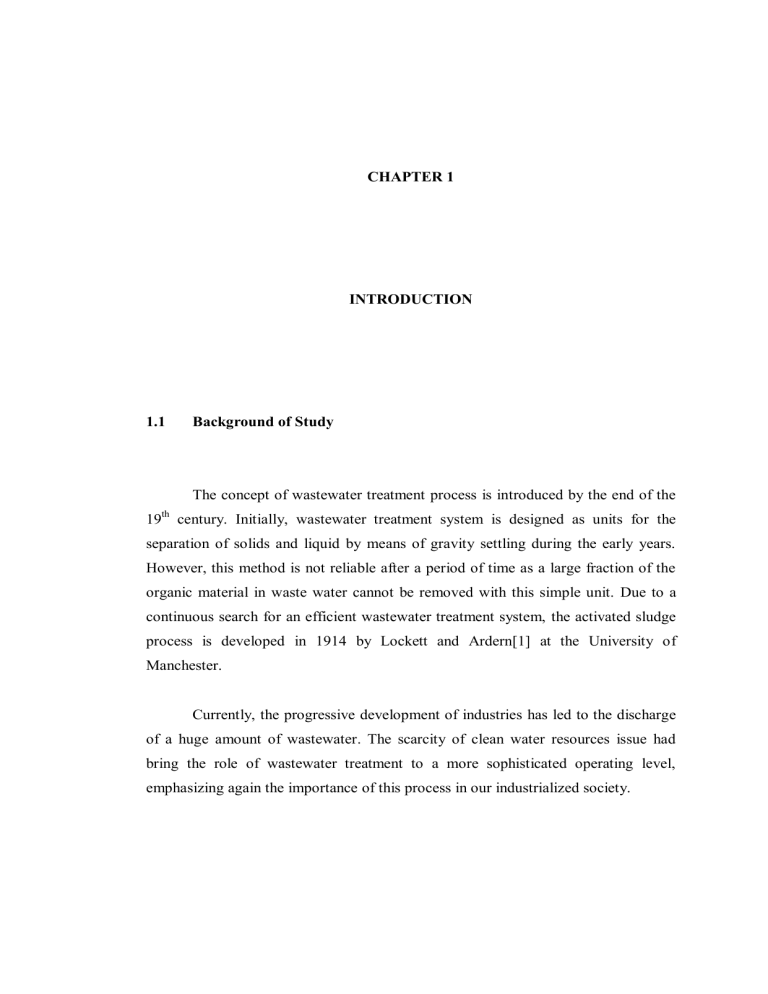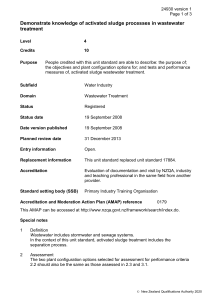CHAPTER 1 INTRODUCTION 1.1

CHAPTER 1
INTRODUCTION
1.1 Background of Study
The concept of wastewater treatment process is introduced by the end of the
19 th
century. Initially, wastewater treatment system is designed as units for the separation of solids and liquid by means of gravity settling during the early years.
However, this method is not reliable after a period of time as a large fraction of the organic material in waste water cannot be removed with this simple unit. Due to a continuous search for an efficient wastewater treatment system, the activated sludge process is developed in 1914 by Lockett and Ardern[1] at the University of
Manchester.
Currently, the progressive development of industries has led to the discharge of a huge amount of wastewater. The scarcity of clean water resources issue had bring the role of wastewater treatment to a more sophisticated operating level, emphasizing again the importance of this process in our industrialized society.
2
1.2 Problem Statement
In wastewater treatment plant (WWTP), a mathematical modeling of an activated sludge process is complicated; hence an extensive mathematics knowledge and thorough understanding of the system’s behavior are required. The biochemical processes involved in the activated sludge process are complex and the understanding of microscopic point of view is very limited. The first development of
Activated Sludge Model No.1 (ASM1) proposed by Henze et al. in 1987[2] had triggered the general acceptance of WWTP modeling, first in the research community and later in the industry as well. Even though the ASM1 model is implemented in different software platforms, the implementation of these software still require high expertise in wastewater treatment field. Hence, an alternative method of modeling activated sludge process should be sought to ease the work.
The activated sludge process in WWTP is highly complex, difficult to control and not all processes involved can be modeled. In activated sludge process, there are biodegradation and sedimentation processes. In the biodegradation process, a composition of high diversity of bacteria, i.e. biomass, is used to remove the organic material in the wastewater in order to achieve the treatment purposes. Therefore, with the existence of variety bacteria, the activated sludge process becomes very complex on a microscopic level. This process becomes more complicated when there are uncountable uncertainties exist on the bacteria’s behavior. The formation of biomass and action on substrates considered as pollutants is hard to control and impossible to be modeled. An accurate description of such complex systems may result in a quite involved model, which may not be useful from a control-engineering viewpoint. Hence in this study, it is a need to obtain a representable model for activated sludge process and yet simple enough to be implemented in control system.
3
1.3 Objectives
The objectives of this project include:
1) To demonstrate the use of data-driven model obtained with System Identification followed by model reduction technique.
System modeling and identification are one of the crucial parts which need to be cautiously taken into account in control design. A representable model may not only preserve the input-output relationship but is practical to be applied for controller design and stochastic simulation.
2) To construct a suitable controller for activated sludge process.
Proportional-Integral-Derivative (PID) controller is utilized in this project in order to control two different parameters in activated sludge process. These two different parameters are Nitrate and Dissolved Oxygen (DO) which are the keystones to the effectiveness of the activated sludge process treating the wastewater.
3) To develop a self-tuning PID Controller
As PID controller remains its popularity since its first introduction in 1939, getting the best combination of Proportional gain ( K
P
), Integral gain ( K
I
) and
Derivate gain ( K
D
) techniques come in handy as well. In this study, swarm intelligence optimization technique is employed to get the best combination gains for the PID controller.
4
1.4 Scope of Study
The scopes of study are listed as below:
1) Derivation of a representable model with the utilization of a set of raw data acquired from real life operating activated sludge process.
2) The best fits of the obtained data-driven model must be at least 80% or higher to be suitable for control design implementation.
3) The order of the obtained data-driven model must be of 10 th
orders or less to serve better for control’s purposes. In this study, two different model reduction techniques are applied in order to reduce the high order of the original model to a lower order while retaining the original system’s characteristic.
4) The reduced order model is implemented with a self-tuning PID controller in order to achieve the minimum value of Integral Time Square Error (ITSE) and eventually implemented for control performance.
5) All of the simulations are done with MATLAB.
5
1.5 Project Report Overview
This section provides a brief outline of the chapters included in this writing.
In Chapter 2, an introduction of activated sludge process is presented. This chapter is aimed to enhance the understanding of this project report for readers from different backgrounds. In addition to that, system identification and model reduction techniques are presented in this chapter, as all these related techniques are employed in order to obtain a simplest possible model capable of describing the input-output relationship closely.
In Chapter 3, PID controller is introduced in the first part while followed by the swarm intelligence optimization technique. This chapter describes the impact of
PID controller implementation on the system and the contribution by each different gain parameters in PID control algorithm.
Chapter 4 summarizes the results and discussions for all the simulations which were performed throughout the overall investigation process. This chapter shows the reduced order models with different model reduction techniques.
Simulations are run in order to check the performance of PI and PID controllers in these reduced order models.
Chapter 5 draws the conclusion for this project and discussed some future research and perspectives.




